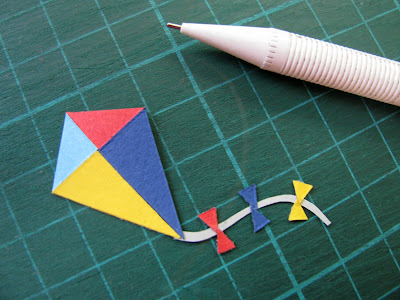A customer ordered one of my extra large cards for her Uncle Ronnie with the intention of framing it for his birthday. She sent me a super long list of the things she and her Mum feel represent him. He is a handy man, she wrote, and so a screwdriver, hammer and nails were requested for the card. He absolutely loves chocolate, especially chocolate from the British chocolatier Paul Young, and particularly loves his hot chocolate, so she asked if I could show him holding a Paul Young hot chocolate drink. She also wanted a peppermint tea to go in somehow too! Uncle Ronnie is a big fan of the Radio 4 programme The Archers and he loves singing Barbara Streisand songs. He also loves cars and gadgets, so cut-outs of a silver SLK Mercedes sports car and a Lexus were requested.
Uncle Ronnie is a Past President of the City of London Law Society so my customer wanted some kind of image relating to the fact that he is a lawyer. He loves skiing and scuba diving and flying kites with the children in the family, oh and she wanted me to show him wearing the Master of Ceremonies red sash that I could see in the photo she sent me. Finally, Uncle Ronnie has the most enormous wonderful winning smile and that should really stand out, she said.
There was a LOT to include!
You can see some of the many cut-outs I created. Above is a picture of the tiny screwdriver, hammer and nails, and below them a paper fox to represent Ronnie's law firm which is called Fox. The fox appears on the card above the Scales of Justice, below. Finally, the colourful kite was also a request.
The card took me, ahem, quite some hours to create and I was delighted to receive the following emails after my customer and her Mum had seen it:
There was a LOT to include!
You can see some of the many cut-outs I created. Above is a picture of the tiny screwdriver, hammer and nails, and below them a paper fox to represent Ronnie's law firm which is called Fox. The fox appears on the card above the Scales of Justice, below. Finally, the colourful kite was also a request.
The card took me, ahem, quite some hours to create and I was delighted to receive the following emails after my customer and her Mum had seen it:
Dear Lisa
I hope that you had a lovely Rosh Hashanah and I wish you and your family a very happy New Year. I cannot even begin to tell you how thrilled my brother was with the card and the fun he had identifying all his special interests - it was a great success and I know that he has already put it up in his home. I'm sure that he would not mind at all your using the card - and I do hope that it brings you in lots of orders - you really deserve the success. You took such immense pains to get everything just right and I do hope that it will help your business go from strength to strength. Thank you again for all your help and patience and if it would help for someone to give a personal recommendation I'd be more than happy to do so."
Her daughter added, "Uncle Ronnie really is one of the most amazing men I know and I absolutely adore him ... you probably feel like you know him better than anyone!".
Um, I think perhaps I do!
I hope that you had a lovely Rosh Hashanah and I wish you and your family a very happy New Year. I cannot even begin to tell you how thrilled my brother was with the card and the fun he had identifying all his special interests - it was a great success and I know that he has already put it up in his home. I'm sure that he would not mind at all your using the card - and I do hope that it brings you in lots of orders - you really deserve the success. You took such immense pains to get everything just right and I do hope that it will help your business go from strength to strength. Thank you again for all your help and patience and if it would help for someone to give a personal recommendation I'd be more than happy to do so."
Her daughter added, "Uncle Ronnie really is one of the most amazing men I know and I absolutely adore him ... you probably feel like you know him better than anyone!".
Um, I think perhaps I do!












































































